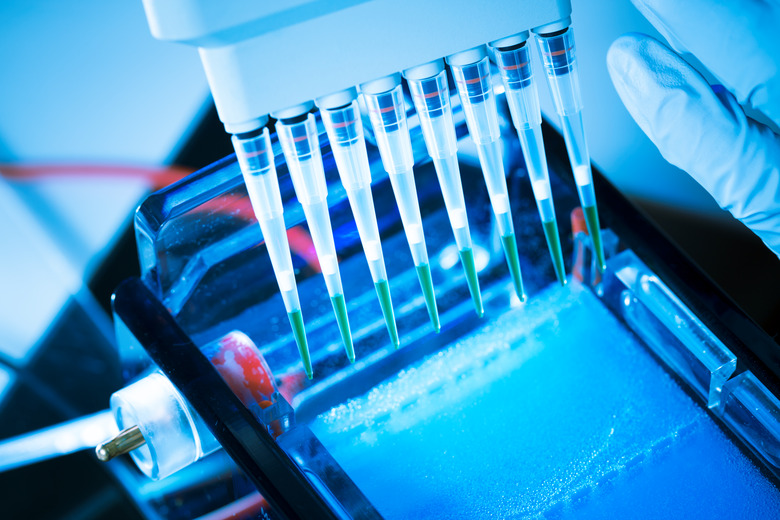The Disadvantages Of Gel Electrophoresis
Gel electrophoresis is a technique where biological molecules are separated from each other and identified in biological research or medical diagnostics. Since their development in the 1970s, these techniques have been invaluable in identifying genes (DNA) and gene products (RNA and protein) of research interest. In recent years, newer techniques have emerged that give greater specificity and detail about what is happening in living systems. While these have not supplanted electrophoresis techniques, and advanced manipulations can expand the viability of the technique, it is important to realize what gel electrophoresis can and cannot do.
Electrophorresis Has Limited Sample Analysis
Electrophorresis Has Limited Sample Analysis
Electrophoresis is specific to whatever tissue you've sampled. For instance, if you run a Southern blot (a type of electrophoresis) on a cheek swab, you're looking at genes from the epithelial cells of your cheek and nowhere else in your body. At times, this can be beneficial, but researchers are frequently interested in more widespread effects.
Techniques such as in situ hybridization (ISH) can take a section of tissue and analyze gene expression at each small area of that sample. Thus, researchers can look at every brain area in a sample with ISH, whereas electrophoresis techniques can only look at a few areas at a time.
Electrophoresis Measurements Are Not Precise
Electrophoresis Measurements Are Not Precise
Gel electrophoresis can effectively separate similar proteins with different weights (this is a technique called Western blotting). It can separate them more precisely through a technique known as 2d electrophoresis; this is common in proteomics.
Unfortunately, all of the measurements made from this technique are semi-quantitative at best. In order to obtain the precise mass (weight) of proteins, mass spectroscopy must be employed after the protein has been purified by electrophoresis. Furthermore, comparing the relative amounts of different molecules relies on the band density (darkness) of different spots on the gel. This method has some degree of error, and samples are usually run multiple times to get clean results.
Substantial Starting Sample is Required
Substantial Starting Sample is Required
Electrophoresis is a technique of isolating and visually identifying different biomolecules. This is done by passing an electrical current through the gel to separate charged molecules of different weights. If the molecule you're interested in isn't common enough, its band will be virtually invisible and difficult to measure.
DNA and RNA can be amplified somewhat before running electrophoresis, but it isn't practical to do this with proteins. Therefore, a large tissue sample is needed to run these assays. This can limit the usefulness of the technique, especially in medical analysis. It's virtually impossible to run electrophoresis on samples from a single cell; flow cytometry and immunohistochemistry are more commonly used to assess cell-by-cell expression of proteins. A technique called PCR is excellent at precisely measuring tiny amounts of RNA.
Only Certain Molecules Can Be Visualized
Only Certain Molecules Can Be Visualized
Electrophoresis is excellent at separating and identifying medium- to large-sized biomolecules. However, many of the molecules that researchers wish to look at are smaller; small hormones, neurotransmitters, and ions cannot be measured by electrophoresis. This is for two reasons: they don't properly react with the electrophoresis preparation (usually a technique called SDS PAGE) and, even if they did, they are too small to separate properly and would rush out the bottom of the gel. These molecules are instead measured by techniques such as RIAAs (radio immunoassays) and ELISAs (enzyme-linked immunosorbant assay).
Electrophoresis is Low Throughput
Electrophoresis is Low Throughput
Gel electrophoresis is generally low throughput, meaning it doesn't produce data especially rapidly. Contrast electrophoresis, where you can look at a small handful of RNA molecules at a time, with PCR (polymerase chain reaction), which can simultaneously assess thousands of samples. Similarly, flow cytometry can take measurements from thousands of individual cells and make complex correlations, while electrophoresis looks at cells en masse and cannot make such fine discriminations. PCR and flow cytometry represent massively parallel and serial processes respectively, and both far outstrip the abilities of electrophoresis to generate research data.
References
- Molecular Station: "Agarose Gel Electrophoresis"
- Journal of Chromatography B; "Effectiveness and limitation of two-dimensional gel electrophoresis in bacterial membrane protein proteomics and perspectives"; Keigo Bunai, et al.; February 5, 2005
- Methods in Biotechnology; "Polyacrylamide Gel Electrophoresis: Advantages and Disadvantages"; September 20, 2009
Cite This Article
MLA
Robison, Christopher. "The Disadvantages Of Gel Electrophoresis" sciencing.com, https://www.sciencing.com/disadvantages-gel-electrophoresis-8003362/. 13 March 2018.
APA
Robison, Christopher. (2018, March 13). The Disadvantages Of Gel Electrophoresis. sciencing.com. Retrieved from https://www.sciencing.com/disadvantages-gel-electrophoresis-8003362/
Chicago
Robison, Christopher. The Disadvantages Of Gel Electrophoresis last modified March 24, 2022. https://www.sciencing.com/disadvantages-gel-electrophoresis-8003362/
